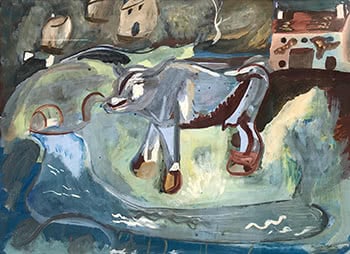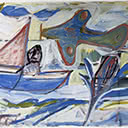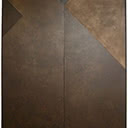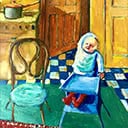The Cow also known as The Calf
52 x 71 cm
est. $100,000 - 150,000
PROVENANCE
Dr Peter Davis Collection Private Collection, Auckland
EXHIBITED
Scottish National Gallery
of Modern Art
Cat. no. 12
Original label affixed verso titled The Calf
Being fiercely proud of his Welsh heritage, it may have been Cedric Morris's recommendation that prompted Frances Hodgkins and her friend Dorothy Selby to spend a fortnight in the tiny fishing village of Solva, Pembrokeshire in October 1936. There was much about village life that would have resonated with Hodgkins' experiences in Spain and the south of France. The village, nestled along the Solva river in a narrow valley opening out into a deep bay, was a popular attraction for sailors and hikers. Although Hodgkins painted several buildings in the village, she and Dorothy preferred to walk from their lodgings at the Cambrian Inn to the tiny enclave known simply as Middle Mill, which boasted a corn and a woollen mill, their large wooden wheels driven by the steady flow of the river.
Hodgkins delighted in the narrow bridge that crossed from the road to the back lane running behind the mills, its three arches reminiscent of others painted on her numerous excursions in the English countryside. The location was sheltered from sea breezes that funnelled up the valley, and when hunger or thirst overcame the two painters, they could retire to the Llanunwas Arms on the far side of the bridge. A small herd of cows were kept in Solva by a farmer known as 'Willie Thomas Panteg'. Each morning, his daughter 'Linda the Milk' would deliver fresh milk to the villagers, before herding the cows up Prendergast Street to the pool below the bridge at Middle Mill. After drinking their fill, she would leave the cows to graze on the water meadow during the day. (1) Thus, Hodgkins was presented with three favourite motifs in one location - the arches of the stone bridge (although she invariably depicted two rather than three); the quaint inn with its glassed-in porch and bothies either end; and ruminating cows on the other side of the narrow river.
After her brief holiday, Hodgkins worked on her Solva paintings in Corfe, where she stayed with her friend Amy Krauss for the next six months or so, and then her studio at Worth Matravers, a few miles away on the coast, where she was based until mid- 1939. She produced at least nine identified works, creating highly individualistic interpretations of what she observed, rearranging and editing favoured motifs into larger exhibition pieces. This practise is illustrated when you compare Sketch for The Cow and the final work under consideration. The sketch shows a relatively anatomically correct beast in scale with its surroundings on the far side of a picket fence, as well as a more rudimentary form taking water from the river. The height of the bridge has been exaggerated, and two rather than three arches drawn. The porch stands out clearly against the front wall of the inn, and the hill rising behind is delineated with hasty smudged brushstrokes.
The Cow is a larger, more polished iteration of the theme. She refined her motifs, removing the second cow, as well as the readily identified inn, instead placing several simple dwellings which create a kind of rhythm in the composition. She simplified the bridge, its curved form echoing the arches below and reminiscent of an ancient burial mound, but it is her treatment of the cow that is most individualistic. On a monolithic scale, the beast is full of character, its horns sweeping sideways rather than forwards, and its body depicted using segments of grey, mysterious smoky pinks, lilacs, blues and browns, a layering technique much remarked on by contemporary critics. There is an exuberance to the composition that suggests not just the pleasure the artist experienced in applying the paint, but also her recollection of 'Solva of blessed memory...' (2) Hodgkins had painted several watercolours of cows being milked when she first went to Europe in 1901, and still kept a photograph of the family's maid Phemie milking their own house cow in Dunedin, and those recollections may have added to her rare sense of contentment at the time.
The Cow was first exhibited in 1948 at a group show at the Leicester Galleries in London, when it was lent by Amy Krauss, who must have acquired it when Hodgkins was living in Corfe. In 1938, Hodgkins had been very taken with Amy's 'shy spectacled ginger coloured nephew' who 'has a crush on me, on my painting - he gets more pleasure from it he says, than from any artist living or dead. Tall order! Nice to think it can set him sweetly dreaming thus. He little knows! (3) Peter Davis, the young man in question, promptly 'badgered my parents into buying two gouaches by this painter whose work I have admired ever since.'(4)
The gouache was shown again, now titled The Calf, in 1964 when Dr Davis lent his collection to the Scottish National Gallery of Modern Art. A renowned botanist, he drew an analogy in his introduction to the Edinburgh exhibition between his field of scholarship and the collecting of paintings, both requiring 'an appreciation of form and colour, an eye for proportion and balance'...(5) Davis had inherited Amy Krauss's collection, and eight Hodgkins paintings were included in the Edinburgh exhibition. A man renowned for a twinkle in his eye, the jaunty cow may well have been his favourite. MARY KISLER
Notes: 1: Paul Raggett, Solva: An Introduction to Village Life and Guide to the Walks, n.p.,5th edition, Printed by D T Pearce, Milford Haven, 2000, p. 24. 2: Frances Hodgkins to Dorothy Selby from Worth Matravers, Dorset, October 7th 1938. 3: Frances Hodgkins to Dorothy Selby from Worth Matravers Dorset, November 30th 1937. 4: Dr Peter Davis, introduction to Modern Paintings and Drawings from the Collection of Dr Peter Davis, Scottish National Gallery of Modern Art, April 18th to May 17th, 1964, n.p. 5: Dr Peter Davis, introduction to Modern Paintings and Drawings.





